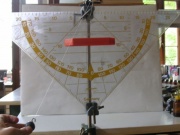Praktikum: Untersuchung eines Fadenpendels: Unterschied zwischen den Versionen
(→Periodenlänge eines Fadenpendels) |
|||
| Zeile 65: | Zeile 65: | ||
| style="height:30px; width:50px;" | | | style="height:30px; width:50px;" | | ||
|- | |- | ||
| − | |<math> \frac{T}{l} \text{in} {\rm \frac{s}{ | + | |<math> \frac{T}{l} \text{in} {\rm \frac{s}{cm} }</math> |
| style="height:30px; width:80px;" | | | style="height:30px; width:80px;" | | ||
| style="height:30px; width:50px;" | | | style="height:30px; width:50px;" | | ||
| Zeile 73: | Zeile 73: | ||
| style="height:30px; width:50px;" | | | style="height:30px; width:50px;" | | ||
|- | |- | ||
| − | |<math> \frac{T}{l^2} \text{in} {\rm \frac{s}{ | + | |<math> \frac{T}{l^2} \text{in} {\rm \frac{s}{cm^2} }</math> |
| style="height:30px; width:80px;" | | | style="height:30px; width:80px;" | | ||
| style="height:30px; width:50px;" | | | style="height:30px; width:50px;" | | ||
| Zeile 81: | Zeile 81: | ||
| style="height:30px; width:50px;" | | | style="height:30px; width:50px;" | | ||
|- | |- | ||
| − | |<math> \frac{T}{\sqrt{l}} \text{in} {\rm \frac{s}{\sqrt{ | + | |<math> \frac{T}{\sqrt{l}} \text{in} {\rm \frac{s}{\sqrt{cm}} }</math> |
| style="height:30px; width:80px;" | | | style="height:30px; width:80px;" | | ||
| style="height:30px; width:50px;" | | | style="height:30px; width:50px;" | | ||
| Zeile 114: | Zeile 114: | ||
*Abhängigkeit von der Amplitude <math>\hat y</math>: | *Abhängigkeit von der Amplitude <math>\hat y</math>: | ||
| − | Masse: | + | Masse m: |
| − | + | Pendellänge l: | |
{| class="wikitable" | {| class="wikitable" | ||
| Zeile 152: | Zeile 152: | ||
| style="height:30px; width:50px;" | | | style="height:30px; width:50px;" | | ||
|- | |- | ||
| − | |<math> \frac{T}{ | + | |<math> \frac{T}{\hat y^2} \text{in} {\rm \frac{s}{\circ ^2} }</math> |
| style="height:30px; width:80px;" | | | style="height:30px; width:80px;" | | ||
| style="height:30px; width:50px;" | | | style="height:30px; width:50px;" | | ||
| Zeile 160: | Zeile 160: | ||
| style="height:30px; width:50px;" | | | style="height:30px; width:50px;" | | ||
|- | |- | ||
| − | |<math> \frac{T}{\sqrt{ | + | |<math> \frac{T}{\sqrt{\hat y}} \text{in} {\rm \frac{s}{\sqrt{\circ}} }</math> |
| style="height:30px; width:80px;" | | | style="height:30px; width:80px;" | | ||
| style="height:30px; width:50px;" | | | style="height:30px; width:50px;" | | ||
Version vom 1. Oktober 2015, 15:07 Uhr
Untersuchungsauftrag: Wovon hängt die Frequenz des frei schwingenden Pendels ab?
- Untersuchen Sie experimentell, wovon die Frequenz, bzw. die Schwingungsdauer eines Pendels abhängt.
Mögliche Beeinflussungen durch:
- Pendellänge l
- Masse m
- Amplitude [math]\hat y[/math]
- Reibung
- Antrieb
Man darf immer nur eine Größe variieren und dann jeweils die Periode messen. Misst man z.B. für verschiedene Amplituden die Periode erhält man einen Zusammenhang zwischen Amplitude und Periodendauer, der streng genommen nur für die gewählte Länge, Masse usw. gilt.
Ändert sich die Periode bei Variation einer Größe nicht, so ist sie davon unabhängig.
Periodenlänge eines Fadenpendels
- Vereinfachung des Uhrenpendels als Fadenpendel (mathematisches Pendel)
- Die Masse wird als punktförmig angenommen, die Aufhängung als masselos.
- Weitere Vereinfachung: Ungedämpftes Pendel (Ohne Energieverlust)
- Aufbau
Mittels einer Klemme wird eine Stange senkrecht an einem Tisch angebracht. An dieser Stange wird am oberen Ende eine kleine Querstange befestigt und an dieser eine Klemme.
Mit der Klemme wird nun ein Faden befestigt, an dessen Ende ein kleines Gewicht hängt.
- Zur Untersuchung der Abhängigkeit von einer Größe muß diese variiert und alle anderen konstant gehalten werden.
- Beobachtung/Messwerte
- Abhängigkeit von der Pendellänge l:
- Die Pendellängen sollen ca. folgende Werte haben: 50cm, 40cm, 30cm, 20cm, 10cm, 5cm.
Masse m:
Amplitude [math]\hat y[/math]:
| l in cm | ||||||
| 10 T in s | ||||||
| T in s | ||||||
| [math] \frac{T}{l} \text{in} {\rm \frac{s}{cm} }[/math] | ||||||
| [math] \frac{T}{l^2} \text{in} {\rm \frac{s}{cm^2} }[/math] | ||||||
| [math] \frac{T}{\sqrt{l}} \text{in} {\rm \frac{s}{\sqrt{cm}} }[/math] |
- Abhängigkeit von der Masse m:
- Durch Anhängen eines zweiten Gewichts kann man die Masse verdoppeln.
Pendellänge l:
Amplitude [math]\hat y[/math]:
| m in kg | ||
| 10 T in s | ||
| T in s |
- Abhängigkeit von der Amplitude [math]\hat y[/math]:
Masse m:
Pendellänge l:
| [math]\hat y[/math] in ° | 5° | 10° | 20° | 40° | 60° | 80° |
| 10 T in s | ||||||
| T in s | ||||||
| [math] \frac{T}{\hat y} \text{in} {\rm \frac{s}{\circ} }[/math] | ||||||
| [math] \frac{T}{\hat y^2} \text{in} {\rm \frac{s}{\circ ^2} }[/math] | ||||||
| [math] \frac{T}{\sqrt{\hat y}} \text{in} {\rm \frac{s}{\sqrt{\circ}} }[/math] |
- Erklärung/Auswertung
Die gemessenen Zusammenhänge werden jeweils in ein Koordinatensystem gezeichnet. Man trägt zum Beispiel die Periodendauer (y-Achse) über die Pendellänge (x-Achse) auf.
Um einen rechnerischen Zusammenhang zwischen den Größen zu finden, sucht man nach konstanten Quotienten oder Produkten der Messgrößen. Diese werden in die Tabelle eingetragen.
Als Beispiel hier der Zusammenhang zwischen Periodendauer und Pendellänge. Es kommen mehrere Möglichkeiten in Betracht:
- [math]T = c \cdot l \quad \Leftrightarrow \quad c = \frac{T}{l}[/math]
- [math]T = c \cdot l^2 \quad \Leftrightarrow \quad c = \frac{T}{l^2}[/math]
- [math]T = c \cdot \sqrt{l} \quad \Leftrightarrow \quad c = \frac{T}{\sqrt{l}}[/math]
Man berechnet daher alle Quotienten und untersucht, ob ein Quotient für alle Messungen ungefähr gleich bleibt.
